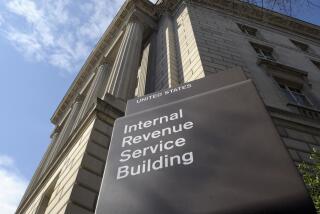Flat-tax plans aren’t the answer
Three major Republican presidential candidates want to replace all or part of the byzantine federal tax code with a “flat tax” that collects a fixed percentage of one’s income, with no brackets and few exemptions. The change would give Americans more incentive to save and invest, and less incentive to cheat. But there are other ways to obtain the economic benefits promised by a flat tax without asking the middle class to shoulder more of the tax burden now borne by those at the top.
Originally proposed in 1981 by Stanford University scholars Robert E. Hall and Alvin Rabushka, the flat tax is a variation on the value-added taxes imposed in Europe. Former Godfather’s Pizza Chief Executive Herman Cain has called for a flat 9% tax on personal and corporate incomes along with a 9% national sales tax. Former House Speaker Newt Gingrich of Georgia, who once ridiculed presidential contender Steve Forbes’ flat-tax plan as “nonsense,” now proposes to give individual taxpayers the option of paying a flat tax of 15% in lieu of complying with the current code. And this week Texas Gov. Rick Perry is expected to unveil a similar proposal for an optional flat tax of 20%.
The simplicity of a single rate might be the most appealing aspect of the flat tax to taxpayers, but the majority of its benefits would come from broadening the tax base, lowering rates and removing disincentives to save and invest. The biggest downside is that by sharply reducing the rates collected from the highest earners, it would force the lower and middle classes to cover more of the cost of government than under the current system of graduated rates.
Making the flat tax an option, as Gingrich and Perry favor, is a worst-of-both-worlds approach. It wouldn’t reduce taxpayers’ paperwork and expenses; they’d still need to calculate how much they’d owe under the current system to see whether they would pay less with the flat tax. Instead, it would let lower-income taxpayers and the elderly hold onto the valuable tax breaks that the flat tax would eliminate, while letting higher incomes take advantage of the flat tax’s lower rates. In other words, it’s status quo for those with lower incomes, but a boon to the wealthy.
Lawmakers can achieve the legitimate economic goals of the flat tax without abandoning graduated rates. One example is the tax overhaul that President Reagan signed into law in 1986, which eliminated enough tax breaks to allow brackets to be consolidated and the top rate lowered significantly. Flat-tax advocates are right to call for a radically simpler code, but they’re focusing on the wrong problem.
More to Read
A cure for the common opinion
Get thought-provoking perspectives with our weekly newsletter.
You may occasionally receive promotional content from the Los Angeles Times.






